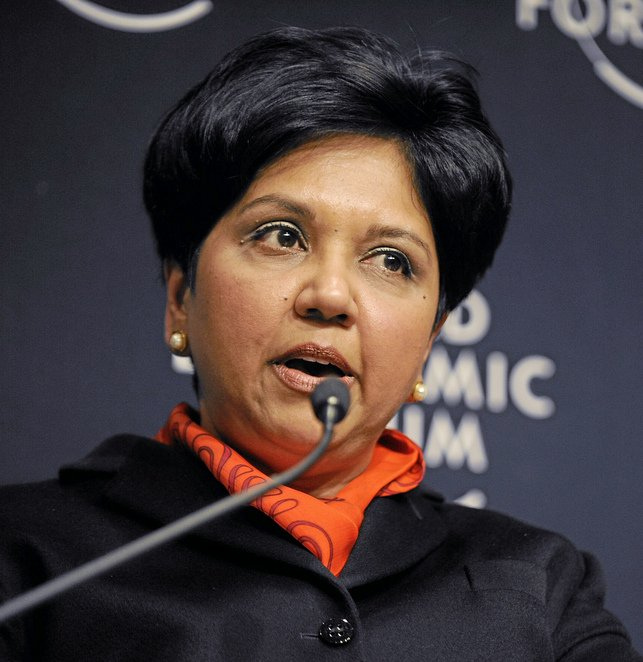The steam from my coffee cup was fogging up the lower half of my laptop screen, blurring the spreadsheet I was supposed to be finishing. Outside the little café on Chapel Street, a group of Yale students walked by, their laughter echoing briefly before being swallowed by the New Haven air. They were a vibrant, diverse mix—a snapshot of modern academia. I saw young men and women, walking shoulder to shoulder, backpacks laden with books and ambition.
It’s a sight that can make you feel a swell of pride. We did it, right? We fought the battles, broke the glass ceilings (or at least cracked them significantly), and now the hallowed halls of institutions like Yale, Harvard, and Princeton reflect a world closer to the one we actually live in. Women, for several years now, have represented at or over 50% of the incoming classes at most Ivy League schools. The numbers are in, the gates are open. Victory.
But as I sat there, I remembered an interview I’d watched with Indra Nooyi, the former Chairman and CEO of PepsiCo and a formidable alumna of the Yale School of Management. She wasn’t just talking about numbers. She was talking about something deeper, something that gnaws at the edges of this apparent victory. She was talking about the investment.
And that’s when the entire picture shifted for me. We often discuss gender equity as a matter of social justice, of fairness, of representation. And it is all of those things. But Nooyi, with her razor-sharp business acumen, forces us to look at it through another, equally critical lens: the lens of Scholarship & Funding.
This isn’t just a story about who gets in. This is a story about the return on a multi-billion dollar investment in human potential.
Act I: The Great Admissions Victory (Or So We Thought)
Let’s start with the good news, because it’s genuinely worth celebrating. For the Fall 2023 entering class (the Class of 2027), the numbers were staggering. Brown University welcomed a class that was 52% women. At Dartmouth, it was 53%. At Harvard, 53.6%. Yale, my coffee-shop-view alma mater, has consistently hovered around the 50-51% mark for its undergraduate college.
This is a monumental achievement. Imagine telling someone in the Yale Class of 1971—the first undergraduate class to include women—that within a few generations, the campus would be not just co-ed, but majority-female in some cases. It would have sounded like science fiction.
This parity is the direct result of decades of advocacy, changing social norms, and—crucially—financial commitments. Universities have poured millions into outreach, into creating inclusive campus environments, and into scholarships designed to attract the best and brightest, regardless of gender. Families have invested their life savings. Students have taken on significant loans, betting on themselves and the promise of an Ivy League degree.
From a pure admissions standpoint, the first line item on the balance sheet looks fantastic. The asset we are acquiring—a diverse, brilliant student body—is balanced. We’ve funded the entry point. We’ve paid the price of admission.
So, have we won?

Indra Nooyi’s perspective suggests we’re celebrating at halftime. She challenges us to look beyond the acceptance letter and ask the tough, fiscal question: What happens to that investment after graduation?
Act II: The Leaky Pipeline and the Depreciating Asset
Think of every student admitted to an Ivy League institution as a massive investment.
- The University’s Investment: Endowments, scholarships, grants, state-of-the-art facilities, and the salaries of world-class professors. Yale’s endowment is over $40 billion. A significant portion of that is dedicated to ensuring that the students it educates have every possible resource. Much of this is funded by donors who believe they are investing in future leaders.
- The Family’s Investment: For those who pay, the sticker price for an Ivy League education is north of $80,000 per year. That’s a $320,000+ bet on a child’s future. It’s often the single largest financial commitment a family will ever make, outside of their home.
- The Student’s Investment: Years of relentless hard work, sacrificed social lives, and for many, the burden of student loans that will follow them for decades. It’s an investment of youth, time, and future earnings.
In business, when you make a significant capital investment, you track its performance meticulously. You measure its output, its efficiency, its return on investment (ROI). If a billion-dollar factory only operated at 50% capacity, the board would be in an uproar.
This is where Nooyi’s critique comes into focus. She speaks of the “leaky pipeline.” While women are pouring into the front end of the pipeline in equal, if not greater, numbers, they are “leaking out” at disproportionate rates at every subsequent stage of their careers.
The data, unfortunately, backs her up.
- The Major-to-Career Funnel: While progress has been made, women in Ivies are still less likely to major in the highest-paying fields like computer science and finance. A 2021 study of Harvard graduates showed a persistent gender pay gap, partially explained by differences in concentration and career choice immediately after college. The investment is equal at the start, but the immediate financial trajectory begins to diverge almost instantly.
- The Mid-Career Cliff: This is the biggest leak. Women who graduate with the same stellar degrees, the same ambition, and the same potential as their male counterparts are far more likely to see their careers stall or stop in their 30s and 40s. The reasons are systemic and complex, but they often boil down to what Nooyi calls the lack of a “care infrastructure.” The societal expectation and structural reality is that women still bear the overwhelming responsibility for childcare and elder care. When a choice has to be made between a demanding C-suite track and family, the structure of our society forces the choice disproportionately onto women.
Every brilliant woman who downshifts her career, takes a lower-paying flexible job, or leaves the workforce entirely represents a depreciation of that initial, massive investment. Her potential, funded by Yale’s endowment and her family’s savings, is not fully realized in the marketplace or in leadership.
Society gets a lower return. The university’s mission to produce world-changing leaders is only partially fulfilled. The family’s financial sacrifice yields a lower dividend.
This isn’t a judgment on individual choices. It is an indictment of a system that presents those choices so unfairly.

Act III: Reframing “Scholarship & Funding” for the Long Haul
This brings us back to the category of this blog: Scholarship & Funding.
We have historically defined “funding” in the context of higher education as the money that gets a student to and through college. We fund scholarships for tuition. We fund grants for research. We fund the construction of new labs.
Indra Nooyi’s perspective demands a radical expansion of that definition. If the goal is to maximize the return on our investment in talent, then we must fund the entire ecosystem that allows that talent to flourish, not just for four years, but for forty.
What would this new, holistic approach to funding look like?
- Funding the Pipeline, Not Just the Entrance: Instead of general scholarships, what about creating heavily endowed funds specifically to support women throughout their time in male-dominated, high-earning fields? This means funding not just tuition, but also specialized mentorship programs, conference travel, and paid internships that create solid pathways into industries like venture capital, AI development, and quantitative finance. It’s about de-risking the choice to enter these fields.
- Post-Graduation “Bridge” Funding: This is a radical idea, but what if university endowments, as part of their mission, allocated a small percentage to “continuity funding” for alumni? Imagine a Yale-funded grant that helps a female founder secure childcare so she can get her startup off the ground. Or a “re-entry” scholarship for an alumna who took five years off for family and now needs to re-skill to re-enter the tech workforce. We fund study abroad; why not fund the critical transitions that preserve the initial investment?
- Investing in Sponsorship, Not Just Mentorship: Mentorship is advice. Sponsorship is advocacy. A mentor tells you how to play the game; a sponsor pulls you onto the field. Universities could use their powerful alumni networks to create funded, structured sponsorship programs. Imagine connecting a promising female engineering senior not just with a mentor at Google, but with a senior executive sponsor who is incentivized to actively advocate for her first promotion. This is about funding the creation of social capital, which is often more valuable than financial capital.
- Advocacy as an Investment: Universities, with their immense lobbying power and societal influence, could view funding policy advocacy as part of their educational mission. Investing in lobbying for national paid family leave, subsidized childcare, and other “care infrastructure” policies isn’t a political act; it’s a fiduciary one. It ensures that the “product” they create—highly educated leaders—can function at full capacity in the real world. It’s protecting their investment.
Conclusion: From Counting Heads to Making Heads Count
I looked away from my laptop, back out the window. The group of students was gone. In their place, a young woman was sitting on a bench, head buried in a thick textbook, her focus absolute.
I saw her not just as a student, but as an asset. A multi-million dollar asset on society’s balance sheet. An investment of hope, money, and boundless potential.
The victory of gender parity in Ivy League admissions is real, and it is sweet. But it is the beginning of the story, not the end. Indra Nooyi’s perspective is a powerful, pragmatic call to action. It tells us that true equity isn’t just about opening the door. It’s about ensuring the path beyond that door is structurally sound, financially supported, and leads all the way to the top.
It’s time for our concept of “Scholarship & Funding” to graduate. We need to move beyond simply funding a four-year education and start investing in a forty-year career. We’ve gotten brilliant at counting the heads of the women entering our most elite institutions. Now, the real work begins: creating a world where we can truly make every single one of those heads count.
Sources & Further Reading
This list is categorized to align with the key arguments in the article. It includes direct links to reports, interviews, academic studies, and data sources that explore gender equity from admissions through to the highest levels of the workforce.
Category 1: Indra Nooyi’s Views & The “Care Infrastructure”
- Book: My Life in Full: Work, Family, and Our Future
- Source: Indra Nooyi
- Link: Penguin Random House
- Description: The foundational text for Nooyi’s perspective. It details her personal journey and provides a full-throated argument for building a national “care infrastructure” to support working families and unleash economic potential.
- Video Interview: “Indra Nooyi on Work, Life and the ‘Massive Juggling Act’”
- Source: The Wall Street Journal
- Link: YouTube
- Description: A concise and powerful video where Nooyi explains the direct conflict between the “biological clock” and the “career clock” and why societal support systems are essential for solving this conflict.
- Article: “Why Indra Nooyi says we need to think of women in the workforce as ‘an economic opportunity'”
- Source: Fortune
- Link: Fortune
- Description: This article frames Nooyi’s argument in the exact economic terms used in the blog post—viewing the full participation of women not just as a social issue, but as a massive, untapped economic opportunity.
Category 2: Ivy League & Elite University Gender Admissions Data
- Official University Profiles (Class of 2026/2027)
- Source: University Admissions Offices
- Yale University Class of 2026 Profile: Yale Admissions (Shows 52% women)
- University of Pennsylvania Class of 2026 Profile: UPenn Admissions (Shows 54% women)
- Dartmouth College Class of 2026 Profile: Dartmouth Admissions (Shows 51% women)
- Description: These direct university sources provide the official demographic data for recent incoming classes, confirming the trend of gender parity or a female majority in admissions.
- Article: “For the Class of 2027, a Majority of Ivy League Schools are Majority-Female”
- Source: BestColleges.com
- Link: BestColleges
- Description: A helpful roundup article that synthesizes admissions data across the Ivy League for the most recent cycle, highlighting the consistent trend of female-majority admitted classes.
Category 3: Post-Graduation Outcomes & The Gender Pay Gap
- Report: “The Simple Truth About the Gender Pay Gap”
- Source: American Association of University Women (AAUW)
- Link: AAUW Report
- Description: An annually updated, data-rich report that breaks down the gender pay gap by age, race, education level, and profession. It clearly shows how the gap widens significantly during the mid-career years, corroborating the “leaky pipeline” effect.
- Academic Study: “Dynamics of the Gender Gap in High-Skill Occupations”
- Source: Harvard University & NBER (National Bureau of Economic Research)
- Link: NBER Working Paper
- Description: A deep academic dive that examines the gender gap among highly educated professionals (e.g., MBAs, JDs, MDs). It finds that while men and women start with similar earnings, a significant gap emerges within a decade, largely due to differences in career interruptions and hours worked, often linked to childcare.
- Article: “The Gender Pay Gap at the Top”
- Source: The University of Chicago Booth School of Business Review
- Link: Chicago Booth Review
- Description: This article analyzes research on the earnings of high-achieving professionals. It highlights that the gender pay gap is largest for the highest earners, reinforcing the idea that women are not reaching the top rungs at the same rate or with the same compensation as men.
Category 4: The “Leaky Pipeline,” Sponsorship, and Corporate Realities
- Report: “Women in the Workplace 2023”
- Source: McKinsey & Company and LeanIn.Org
- Link: McKinsey Report
- Description: The definitive annual study on the state of women in corporate America. It provides the core data on the “broken rung” (the first step up to manager) and the steady attrition of women at every level of the corporate ladder.
- Article: “Why Sponsorship Is a Better Tool Than Mentorship for Diversity and Inclusion”
- Source: Harvard Business Review
- Link: HBR Article
- Description: A clear, actionable article that defines sponsorship and explains why it is a more powerful mechanism than mentorship for helping underrepresented groups, including women, break through into leadership roles.
- Report: “The Sponsor Dividend”
- Source: Catalyst
- Link: Catalyst Research
- Description: Catalyst is a leading nonprofit focused on women in business. This report provides the research backing the power of sponsorship, showing how it directly correlates with pay increases, high-profile assignments, and career satisfaction for women.
Category 5: The Economics of Care & Systemic Solutions
- Report: “The Economics of Child Care and Early Childhood Education”
- Source: The White House Council of Economic Advisers
- Link: White House Archives (Note: 2015 report, but foundational)
- Description: A government report that lays out the market failures in the childcare system and frames investment in care as a crucial economic policy for boosting labor force participation, productivity, and economic growth.
- Analysis: “Want to grow the economy? Fix the child care crisis.”
- Source: The Brookings Institution
- Link: Brookings Article
- Description: An analysis from a respected think tank that connects the dots between a dysfunctional childcare market and constrained economic growth, making the case for public investment as a pro-growth strategy.


